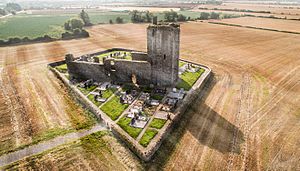Baldongan Church facts for kids
Quick facts for kids Baldongan Church |
|
|---|---|
|
Túr Bhaile Donnagáin
|
|
 |
|
| 53°33′11″N 6°07′44″W / 53.55316°N 6.128776°W | |
| Location | Baldongan Close, Skerries, County Fingal |
| Country | Ireland |
| Denomination | Pre-Reformation Catholic |
| History | |
| Founded | 13th century |
| Architecture | |
| Style | Norman |
| Years built | 13th century |
| Specifications | |
| Length | 34 m (112 ft) |
| Width | 7.5 m (25 ft) |
| Height | 21 m (69 ft) |
| Materials | stone |
| Administration | |
| Diocese | Dublin |
Baldongan Church, also known as Baldungan Castle, is an ancient ruined church and a special National Monument in Ireland. It is located near Skerries in County Dublin. This historic site has a long and interesting past, stretching back many centuries.
Contents
Where is Baldongan Church?
Baldongan Church is found in a quiet, countryside area of north County Dublin. This region is now called County Fingal. It is located about halfway between the towns of Skerries and Lusk. The site is also about 2.4 kilometers (1.5 miles) from the seashore.
A Look Back in Time: The History of Baldongan
Baldongan has a rich history, starting with an early church and later becoming a fortified castle.
The First Church
Records show that an earlier church stood on this spot around the year 1190. This church was given to the Priory of St Mary at Kilbixy.
From Castle to Church
Baldongan was originally a fortified church. It was built like a rectangle with strong towers at each corner. The Knights Templar, a famous group of medieval knights, built it in the 13th century. They built it on the site of an even older ancient fort, known as a dún.
Changing Hands
When the Knights Templar group was ended in 1313, the Archbishop of Dublin took over Baldongan. Over the years, the property changed owners many times. Important people like Sir Reginald de Barnwall and Peter Trevers owned it. Later, it became part of a marriage agreement for Christopher St Lawrence in 1508.
The 1640s Rebellion
During a rebellion in the 1640s, a group of Irish soldiers held the castle. In June 1642, the Irish Royal Army attacked the castle using cannons. The soldiers inside eventually gave up. Most of the men were captured, but two priests were sent away to France.
The "Nuns Stood" Legend
There is a field nearby called the "Nuns Stood." People say that local nuns watched the castle being destroyed from this spot. However, there are no records of a convent ever being close by. The original castle buildings are no longer visible above ground today.
The Later Church
The church you see today was built in the 15th century. It had a tall, strong bell tower, about 21 meters (69 feet) high. This tower was about 6.7 meters (22 feet) square.
What Remains Today
The oldest gravestone you can still see at the site is from March 20, 1735. However, reports from a royal visit in 1615 already mentioned that the church and its main area were in ruins even then.
An artist named Francis Grose drew the church in 1791. His drawing shows the church looking very much like it does today. It even showed a place for two bells and the coat of arms of the Earl of Howth on the front.



